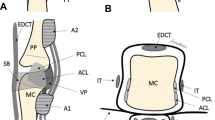Abstract
Purpose
To date, no in vivo study is available regarding the measurement of the contact area of the metacarpophalangeal joints (MP joints) and carpometacarpal joints (CM joints) when the subject grasps specific objects; therefore, this study conducted magnetic resonance imaging of fingers in the neutral posture and while grasping three spheres with different diameters and measured the contact areas of the second to fifth MP and CM joints.
Methods
The study included six Japanese male subjects with no hand injuries or disorders. The following four postures were used: neutral posture, in which all fingers were extended without holding a sphere, and postures while grasping three different spheres with varying diameters (40, 67, and 97 mm).
Results and Conclusion
In the second MP joint, the contact area while grasping a ping-pong ball (diameter, 40 mm) was significantly larger than that while grasping a tennis ball (diameter, 67 mm). Although the grasped spheres were changed, no significant changes were observed in the contact areas of joints other than the second MP joint. The contact areas of the second and third CM joints were significantly larger than those of the fourth and fifth CM joints. In the fourth CM joint, the contact area in the neutral posture was significantly larger than that while grasping a tennis and ping-pong ball. In the second and third CM joints, no significant changes were observed in the contact area of each bone, although the posture was changed.









Similar content being viewed by others
References
Napier, J. R. (1956). The prehensile movements of the human hand. Journal of Bone and Joint Surgery,38B(4), 902–913.
Landsmeer, J. M. F. (1962). Power grip and precision handling. Annals of the Rheumatic Diseases,21(2), 164–170.
Kamakura, N., Matsuo, M., Ishii, H., Mitsuboshi, F., & Miura, Y. (1980). Patterns of static prehension in normal hands. American Journal of Occupational Therapy,34(7), 437–445.
Sangole, A. P., & Levin, M. F. (2008). Arches of the hand in reach to grasp. Journal of Biomechanics,41(4), 829–837.
Kapandji, I. A. (2007). The physiology of the joints, Volume 1: Upper limb (6th ed.). New York: Churchill Livingstone.
Nakamura, K., Patterson, R. M., & Viegas, S. F. (2001). The ligament and skeletal anatomy of the second through fifth carpometacarpal joints and adjacent structures. Journal of Hand Surgery,26A(6), 1016–1029.
Gülke, J., Wachter, N. J., Geyer, T., Schöll, H., Apic, G., & Mentzel, M. (2010). Motion coordination patterns during cylinder grip analyzed with a sensor glove. Journal of Hand Surgery,35A(5), 797–806.
Shimawaki, S., Murai, M., Nakabayashi, M., & Sugimoto, H. (2019). Measurement of flexion angle of the finger joint during cylinder gripping using a three-dimensional bone model built by X-ray computed tomography. Applied Bionics and Biomechanics. https://doi.org/10.1155/2019/2839648.
Moran, J. M., Hemann, J. H., & Greenwald, A. S. (1985). Finger joint contact areas and pressures. Journal of Orthopaedic Research,3(1), 49–55.
Tamai, K., Ryu, J., An, K. N., Linscheid, R. L., Cooney, W. P., & Chao, E. Y. (1988). Three-dimensional geometric analysis of the metacarpophalangeal joint. Journal of Hand Surgery,13A(4), 521–529.
Sakamoto, M., Kasuga, Y., Kazama, K., & Kobayashi, K. (2015). Three-dimensional in vivo analysis of the contact area and motion of the metacarpophalangeal joint of the index finger using MRI. Japanese Journal of Clinical Biomechanics,36, 7–15.
Sugita, K., Sakamoto, M., Morise, Y., Kazama, K., Kobayashi, K., & Tanabe, Y. (2017). In vivo three-dimensional analysis of the contact behavior of the metacarpophalangeal joint of the middle finger. Japanese Journal of Clinical Biomechanics,38, 103–111.
Batmanabane, M., & Malathi, S. (1985). Movements at the carpometacarpal and metacarpophalangeal joints of the hand and their effect on the dimensions of the articular ends of the metacarpal bones. The Anatomical Record,213(1), 102–110.
El-Shennawy, M., Nakamura, K., Patterson, R. M., & Viegas, S. F. (2001). Three-dimensional kinematic analysis of the second through fifth carpometacarpal joints. Journal of Hand Surgery,26A(6), 1030–1035.
Buffi, J. H., Crisco, J. J., & Murray, W. M. (2013). A method for defining carpometacarpal joint kinematics from three-dimensional rotations of the metacarpal bones captured in vivo using computed tomography. Journal of Biomechanics,46(12), 2104–2108.
Shimawaki, S., Koya, D., Nakabayashi, M., Yoshida, K., Sugimoto, H., & Toishi, M. (2018). Influence of the diameter of grasped spheres on the rotation angle and axis of the second to fifth carpometacarpal joints. Journal of Medical and Biological Engineering. https://doi.org/10.1007/s40846-018-0448-0.
Yoshida, H., Kobayashi, K., Sakamoto, M., & Tanabe, Y. (2009). Determination of joint contact area using MRI. Japanese Journal of Radiological Technology,65(10), 1407–1414.
Momose, T., Nakatsuchi, Y., & Saitoh, S. (1999). Contact area of the trapeziometacarpal joint. Journal of Hand Surgery,24A(3), 491–495.
Marzke, M. W., & Marzke, R. F. (2000). Evolution of the human hand: Approaches to acquiring, analysing and interpreting the anatomical evidence. Journal of Anatomy,197(Pt 1), 121–140.
Author information
Authors and Affiliations
Corresponding author
Rights and permissions
About this article
Cite this article
Shimawaki, S., Koya, D., Nakabayashi, M. et al. Measurement of the Contact Area of the Second to Fifth Metacarpophalangeal and Carpometacarpal Joints During Sphere Grasping Using Magnetic Resonance Imaging. J. Med. Biol. Eng. 40, 128–137 (2020). https://doi.org/10.1007/s40846-019-00496-5
Received:
Accepted:
Published:
Issue Date:
DOI: https://doi.org/10.1007/s40846-019-00496-5




